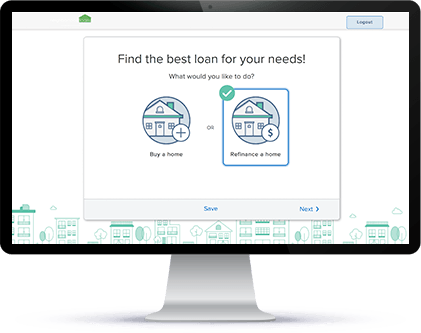Refinance
Your Guide Through a Quick and Easy Refinance Process.
We are ready to walk you through the entire Mortgage Refinance process, step-by-step! Let’s get started.
By the time you finish reading this guide, you will know if a refinance is right for you and the exact steps you need to take to refinance your mortgage.
A Mortgage Refinance is when you finance a new mortgage with new terms and use the new loan to pay off your existing mortgage balance.
The Refinance Process
Adjust Your Mortgage to best Suite Your Needs.

 Step 1.
List Your Goals
Step 1.
List Your Goals
Be sure to let your lender know what you would like to accomplish by refinancing your mortgage.
Whether you’re looking to lower your payment, shorten your term, or use the equity you’ve built over time in your home to get cash back, be sure to let your lender know so they can best help you meet your financial goals.
By listing your goals, your lender will be able to help you decide if it makes sense to refinance your home.
 Step 2.
Learn About Your Options
Step 2.
Learn About Your Options
If you have decided that refinancing is right for you and would like to continue the process, ask your lender to go over your available options for refinancing.
Here are some possible reasons for you to refinance:

1) Lower Mortgage Payment
A lower interest rate translates to a lower monthly payment.
With a consistent loan term and lower monthly payments, you’ll essentially pay less to own your home over the life of your loan.
2) Pay off Your mortgage faster
This can be achieved by refinancing to lower your loan’s term.
For example, you can change your term to go from a 30-year term to a 15-year loan, a 15-year to a 10-year loan
3) Get out of your ARM
This can be achieved by refinancing to change to another loan’s product.
Refinancing can be very beneficial for you when the initial fixed-rate period for your Adjustable-Rate Mortgage (ARM) ends.
Once the fixed period for your ARM is over, you may choose to refinance into another ARM, refinance to a Fixed-Rate loan, or even sell your home.
If you’re no longer planning to sell your home after your ARM’s fixed-rate period ends, refinancing to a fixed-rate loan is probably your best option.
4) Cash Out / Debt Consolidation
A Cash-Out Refinance is a great way for you to extract cash from the equity in your home to pay down other debts or pay for a major expense, such as your child’s college tuition.
You can also consolidate your debt to pay off other high-interest debt, with a cash-out refinance.
Ideally with a Cash-Out Refinance, you will receive a check for the amount you are cashing out and a better rate than what you have, however this isn’t always the case.
5) Eliminate Your Mortgage Insurance
The purpose of private mortgage insurance (PMI) is to protect lenders in case a borrower defaults on a loan. PMI is required if you’re refinancing your home with less than 20% equity.
When your mortgage principal balance reaches 80% of the original property value, you can refinance to a conventional loan with no mortgage insurance.
You can also eliminate your PMI with as little as 5% equity on your home by refinancing to a conventional loan with lender paid mortgage insurance (LPMI) which does not require PMI.
This will last throughout the life of your loan, and may even be costlier for you in the long run if you do not refinance to cancel your LPMI. You need good credit to qualify for lower interest rates and keep costs lower than paying PMI.
Now that you have learned about the different ways that refinancing your mortgage can benefit you, this can help determine if refinancing is the best option for you to achieve your financial goals.

 Step 3.
Complete Your Mortgage Application
Step 3.
Complete Your Mortgage Application
If you decide to proceed with the refinance process, the next step would be to complete your mortgage application.
A mortgage application will require you to submit your financial information to a lender for the purposes of obtaining a mortgage with new loan terms to replace your current mortgage.
Basically, you (borrower) are asked to paint a general picture of your credit worthiness to your lender.
You can meet with your lender if you would prefer to complete your loan application in-person.
Most lenders even allow you to complete a mortgage application online if that is more convenient for you.
What are the 6 pieces of information your lender NEEDS for a complete loan application?
 Name
Name Income
Income Social Security Number (to obtain a credit report)
Social Security Number (to obtain a credit report) Property address
Property address Estimate of the property value
Estimate of the property value Mortgage Loan Amount (amount you owe)
Mortgage Loan Amount (amount you owe)
If you have any questions, ask your loan officer and they will help you complete your mortgage loan application.
Remember, your loan officer will always be available to help you through the process and willing to answer all your questions along the way!
Your loan officer will also look over your loan application to verify, or confirm, that all the information that you provided is valid and correct.
Once they finish reviewing your application, they’ll send it through the channels of their organization to get you approvals needed.

 Step 4.
Choose the Right Loan Product
Step 4.
Choose the Right Loan Product
There are benefits to every refinance loan product.
We’ll help you understand the differences between the products so you can choose the best loan for you.”
Most refinance products can be categorized as the following two categories:
- Fixed-Rate Mortgage
- Adjustable-Rate Mortgage (ARM)
The main difference between the two is that a fixed-rate loan has a consistent payment through the entire term of the loan, whereas an ARM has a fixed rate for a certain period (e.g. a 5/1 ARM is fixed for the first 5 years of the term) and then is adjustable after the fixed period is over.

Deciding which option to go with should depend on two key factors:
1) How long you plan on living in the home, and 2) The current interest rates.
If you plan on living in your home for the long term, you may want to consider refinancing to a fixed-rate mortgage as it will have consistent payments for the life of the loan – protecting you from rising rates.
If you plan on selling your home soon, within the next seven years or so, an ARM may be more beneficial to you as it has a lower interest rate and lower payment than a fixed-rate loan at first – which can save you money if you’re not planning on living in your home longer than the initial fixed-rate period.
Depending on current interest rates, the difference in monthly payments between a fixed-rate loan and an ARM can be minimal or quite significant.
Here's all the refinance options we offer:
Other refinance programs include: FHA and VA.
 Step 5.
Required Docs & Disclosures
Step 5.
Required Docs & Disclosures
Your lender will require you to submit the following documents to verify the information that you have submitted on your application:
- Signed Disclosures
- Full Federal Tax Returns (last two years)
- W-2s (last two years)
- 2 to 5 most recent pay stubs (30 days of consecutive earnings)
- Copy of Mortgage Statement
- Homeowners association info (if applicable)
- Homeowners insurance info(name, agent, phone #)
- Copy of ID/Driver's License

 Step 6.
Review the Loan Estimate
Step 6.
Review the Loan Estimate
Your lender must provide you with is the Loan Estimate, as this is one of the forms required by law for your protection.
Your lender will provide you with the Loan Estimate within 3 business days of submitting a full mortgage loan application and required docs & disclosures.
The Loan Estimate has important information about your loan, such as an estimate of your interest rate, monthly payment amount, and total closing costs for the loan.
To learn more about the Loan Estimate Form and become familiar with the definitions of important terms used, check out the CFPB’s Loan Estimate Explainer.
Keep in mind that the Loan Estimate is only an estimate.
At closing, you will receive a Closing Disclosure that will list the actual charges you will pay.
 Step 7.
Appraisal
Step 7.
Appraisal
Before you can be approved for a refinance, your lender must order a home appraisal to get the estimated market value for your home.
There are several factors that your appraised value is based on, such as number and size of rooms in the home, comparable properties recently sold in the area, and amenities and characteristics that could affect your home’s value.
The appraised value is used by your lender to determine the max loan amount and terms for your refinance.
 Step 8.
Underwriting
Step 8.
Underwriting
After you submit your complete mortgage application and supply the required documentation, your loan officer will forward your paperwork to a processor.
The processor will review and prepare your loan file for underwriting.
An underwriter will review your completed application and request any additional documentation needed to proceed with your loan and get approvals needed for closing.

 Step 9.
Conditional Approval
Step 9.
Conditional Approval
This means that your loan is approved by the underwriter, on the basis that you satisfy specific underwriting conditions before you can schedule a closing on the loan.
You cannot receive a Clear-to-Close (CTC) until you satisfy all the conditions with the underwriter.
Be prepared to submit all requested conditions immediately, as we do not want the rate lock to expire.
If you have any questions regarding your conditional approval or status of your loan, do not hesitate to reach out to your loan officer and ask them to clarify.
 Step 10.
Review & Sign the Closing Disclosure
Step 10.
Review & Sign the Closing Disclosure
Your lender will provide you with is the Closing Disclosure, as this is also a form required by law for your protection.
You will be provided with the Closing Disclosure at least 3 business days prior to your closing date.
The Closing Disclosure has important details about the loan program you selected and was designed to help you understand all the costs incurred in the transaction along with the date of the closing.
If the information on the Closing Disclosure is inaccurate or the figures aren’t the same figures you expected to see, ask your Lender for an explanation why.
To learn more about the Closing Disclosure Form and become familiar with the definitions of important terms used, check out the CFPB’s Closing Disclosure Explainer.

Speak with me
to start the process Get in Touch
 Step 11.
Closing Your Loan
Step 11.
Closing Your Loan
Once all your loan approval contingencies are met, your lender will contact you to authorize your scheduling of a closing date.
At the closing, you will sign the final documents and pay the costs and fees required to close.
Documents Requiring Your Signature Prior to Closing
Promissory Note
This indicates that you accepted the loan terms offered by your lender and agree to repay the amount borrowed, plus the stated interest.
The Note will include the dates when payments are to be made and the place where payments are to be sent.
The Note also explains the consequences of failing to make your mortgage payments.
Mortgage, Security Instrument or Deed of Trust
This document may be called a Mortgage, Security Instrument or a Deed of Trust and will require your signature at closing, which pledges your home as collateral for the loan.
By signing this document, you are giving the lender of your mortgage to seize your property by foreclosure if you fail to pay your mortgage per the terms you’ve agreed to.
Initial Escrow Disclosure
The Initial Escrow Disclosure Statement breaks down the specific charges that you will pay into escrow each month as part of a mortgage agreement.
Affidavits and Declarations
These are legally binding documents which spell out the financial obligation you are taking on and outlines your rights as a homeowner.
Right to Cancel form
You are given up to 3 business days after closing on your refinance to cancel/rescind the loan.
This document explains the rules for when and how to cancel the loan and what is the result of cancelling your loan.
**Be sure to read the documents carefully and ask questions if you don’t understand something from any of these documents**
 Step 12.
Funding Period
Step 12.
Funding Period
When all final closing documents have been signed, your lender’s closing department will review and approve the funding of your loan.
The funding of your loan will take up to 3 business days after closing.










